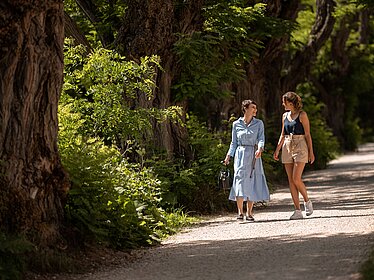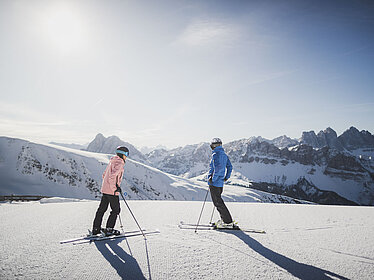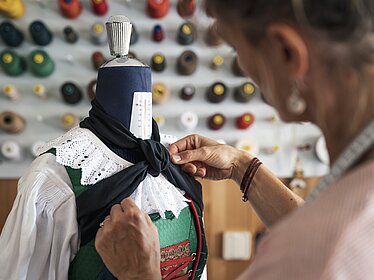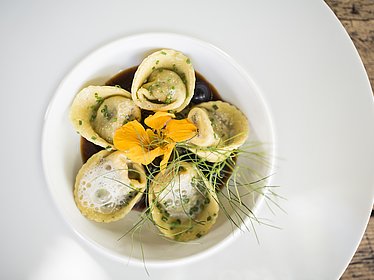The perfect blend of town, country and mountains
Brixen and its surrounding villages
Brixen’s historic, rambling, medieval old town is just one of the jewels in its crown. This beautiful area of South Tyrol is also home to a host of quaint villages, the Plose ski and mountain resort, countless hiking trails and an array of cultural and historical sites. If you’re looking for an unbeatable combination of a vibrant town and tranquil nature, you need look no further than Brixen. Find out more about Brixen and its surrounding villages.

Twice as varied
Art, culture and history play and important role in the historic city centre of Bressanone. The South Tyrolean town is over 1,000 years old; it is the oldest in Tyrol and was often a stopover for Emperors on their travels. It later became a splendid cathedral town. Elephant Soliman had a two week rest in Bressanone on his journey to Vienna in 1552.
Today Bressanone’s history centre offers an interesting mix of joie-de-vivre and reflection. The unique cathedral square, the many listed sacred buildings, the large-scale medieval historic centre, the arcades and the narrow streets framed by merlons, museum treasures, craft tradition and archaeological exhibits wait to be discovered. Modern cafés and excellent restaurants, attractive shops and entertaining events invite you. Bressanone - twice as varied.

Tiles, Scezze, Tecelinga, Pinzago and Caredo
To the West of Bressanone is Monte Ponente with the hamlets of Tiles, Scezze, Tecelinga, Pinzago and Caredo. The hamlets are nestling in ancient chestnut orchards at an altitude of 700 - 900 m. Monte Ponente is also called the “green side” of Bressanone. It is easily reached by car or on a half-day hike along the Chestnut Road “Keschtnweg”.

Bressanone’s local leisure mountain
To the East of Bressanone is Mount Plose, Bressanone’s local leisure mountain. Its slopes promise wonderful views of Bressanone and the low mountain ranges of Valle Isarco, as well as plenty of village entertainment. Here, in a rural farming landscape, among hiking paths, pious churches and pleasurable panorama terraces, there is twice as much enjoyment of the 200 days of sunshine.
S. Andrea and the hamlets of Meluno, Cleran, Cornale, Villa and San Leonardo
S. Andrea and its hamlets of S. Andrea village, Meluno, Cleran, Cornale, Villa and San Leonardo are located halfway up the local leisure mountain Plose at an altitude of 970 m. The Plose cable car that takes you up to 2500 m starts in S. Andrea. The parish of S. Andrea is first mentioned in the records in 1174. The mountain route to Passo delle Erbe also starts in S. Andrea, which is why cyclists and motorcyclists like to stop here.
Eores, Plancios and Valcroce
Eores (1500 m), Plancios (1700 m) and Valcroce (2000 m) are typical mountain villages situated very near the summit. Perched in high altitude they offer stunning views of the surrounding moutainscape and perfect conditions for adventures in the mountains. Twice the challenge every day.
Sarnes
Sarnes (600 m) is situated South of Bressanone. It is known mainly for its Diocesan education centre. Sarnes has long been the summer residence of the high-ranking clergy of Bressanone. Many bishops enjoyed the peace and quiet of Sarnes. Today the village has around 300 inhabitants.
Albes
The village of Albes with 600 inhabitants is situated at 560 m altitude South of Bressanone. The first settlements of the region date back to the Bronze Age. Albes is first mentioned in the records in 955. Today Albes is considered to be small but perfect: a pretty village, charming narrow streets, lovely apple paradise.

The sunshine villages around Bressanone
The holiday villages of Varna, Novacella and Elvas are blessed with plenty of sunshine. Travel writers call this region “the gateway to the South”. The reason is plain to see: Coming from the Brenner, you find the first vines growing here. Already in medieval times the monks of the monastery Abbazia di Novacella made the most of this favourable location in their gardens. Today the villages are meeting points for connoisseurs, art lovers and people with inquiring minds. Lago di Varna and the hiking paths around Elvas offer twice the enjoyment of nature. They are not the same but very similar.
Varna, Scaleres, Spelonca
Varna is situated Northwest of Bressanone. Mountains protect the village from the cold North winds, which is a benefit to winegrowers. Since the Middle Ages inn keepers and craftspeople depended on the brisk traffic along the old Brenner road, the most important North-South axis. Several manor houses owned by the aristocracy and high ranking officials of the Prince Bishop of Bressanone still characterise the village. Varna is known for its hiking and cycling excursions. Lago di Varna is also popular with holidaymakers. At Fiume di Scaleres Kneipp spa is on offer.
Novacella
Novacella is a hamlet with over 800 inhabitants belonging to the municipality of Varna. On the West side the river Isarco flows through the village. Novacella is known for the Abbazia di Novacella, one of the largest monasteries in Tyrol and still an active Augustine monastery. In the autumn Novacella is a popular Törggele destination.
Elvas
Elvas is situated at an altitude of 814 m on a sunny hill Northeast of Bressanone. The 300 inhabitants and the holiday guests enjoy beautiful views of the Bressanone basin. Many prehistoric finds point to an early settlement of sunny Elvas. Hiking, biking, enjoying: Elvas is a jewel for people needing a relaxing break from their busy lives.

Twice the wanderlust
Fortezza and Mezzaselva are situated on the old Brenner road. Emperors and kings have always been passing through: When they rode to coronations in Rome in the Middle Ages, and when soldiers and armies marched from North to the South, they had to cross the Brenner and therefore pass through Fortezza and Mezzaselva.
Today the valley cycle path from Brenner to Bolzano runs through both of these holiday destinations. Also worth seeing are the fortress Fortezza, the climbing crag above the fortress and Lago di Pontelletto, an insider’s tip for people seeking relaxation and one of the most beautiful mountain lakes in South Tyrol.
Fortezza
The village of Fortezza with approx. 1000 inhabitants was named after the impressive fortress Fortezza which was built from 1833 to 1838. Its origins, however, date back more than 4500 years. Already 2500 BC there was a small settlement at this site.
Mezzaselva
Mezzaselva is part of the municipality of Fortezza and has around 200 inhabitants. Originally, Mezzaselva was a parish of its own and Fortezza one of its parts. In 1940 Fortezza was designated as the main village and gave its name to the municipality. The hamlet of Mezzaselva became a part of Fortezza. San Martino church was recorded in Mezzaselva as early as 1345.













